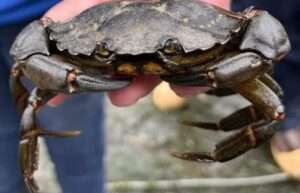
Last year, a new crab species was spotted in Alaska for the first time, and it has the potential to disrupt native species and ecosystems. Since that initial detection of European green crab (Carcinus maenas), local groups, supporting agencies, and Tribes quickly began response efforts, including a recent early-detection training workshop for partners and nearby community members to learn how to detect and sample these invaders.
European green crab are an invasive species in the United States, first appearing on the East Coast in 1817. It wasn’t until 1989 that they were detected on the West Coast, and since then their range has continued to expand northward. They migrated to Washington in 1998, British Columbia in 1999, and Haida Gwaii on the northern Pacific coast of Canada in 2020. They were first identified in Alaska at Annette Island in July 2022, when biologists working with the Metlakatla Indian Community monitoring for invasive species found a carapace on the beach at Tamgas Harbor, located near the community of Metlakatla. These invasive crabs have distinctive carapace characteristics unlike crabs native to Alaska; five spines on either side of the eyes and three bumps between the eyes.
Since that time, the Metlakatla Indian Community has trapped upwards of 800 European green crabs, including egg-bearing females. The Metlakatla Indian Community, NOAA Fisheries, and the Alaska Department of Fish and Game are taking action to study and address the impacts an expanding population could have on habitat and native crab species. Adult European green crabs may prey on juvenile Dungeness and other small native crabs, including shore crab, kelp crab, and rock crab, as well as mussels, snails, oysters, and worms. European green crabs also dig for clams, tearing up eelgrass, an important habitat for juvenile fish.
Responding to the need for increased European green crab monitoring in southern Southeast Alaska, Alaska Sea Grant joined with the Metlakatla Indian Community, NOAA, Alaska Department of Fish and Game, Southeast Alaska Tribal Ocean Research (SEATOR), and the Organized Village of Kasaan to host a two-day workshop for regional residents and agency employees that spend time on beaches where European green crab may be expanding. Thirty-three participants from 10 different Southeast Alaska communities attended, representing the U.S. Coast Guard, U.S. Forest Service, ecotourism operators, University of Alaska Fairbanks, University of Alaska Southeast, and tribal organizations including the Central Council of the Tlingit and Haida Indian Tribes of Alaska.
Workshop participants spent a half-day learning about the history and biology of the European green crab invasion, how to distinguish these crabs from native crab species, and how to monitor for their presence, either through beach walks looking for crab shells, or by trapping live specimens. On the second day, the group was hosted by the Metlakatla Indian Community and traveled to Tamgas Harbor to see live European green crab and their habitat, learn where to look for green crab, and practice trapping. All of the respondents of a follow-up survey indicated they gained the information needed to begin monitoring in their communities.

Anyone can help keep an eye out for European green crab on their local beach. Walk along the wrack line (the high tide mark where debris accumulates), or even higher in the beach grass, and examine every crab carapace you see. European green crab can be identified by the number of spines on the leading edge of the shell between the eye and the outer spine. European green crab will have five prominent spines on each side and three rounded bumps between the eyes. They are not always green. If you think you may have found European green crab, note your location, take a picture, and call the Alaska Department of Fish and Game invasive species hotline at 1-877-INVASIV.
If you would like to help distribute information alerting people to European green crab, you can request stickers from the Alaska Sea Grant online store.
For additional information, contact Sunny Rice, Alaska Sea Grant’s Marine Advisory Program agent based in Petersburg.
